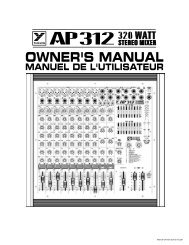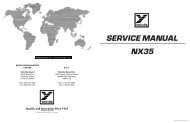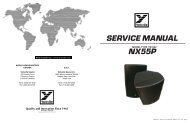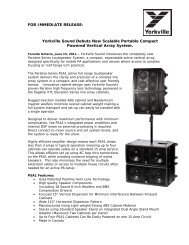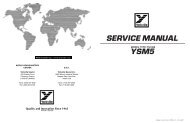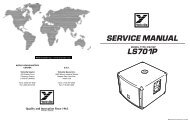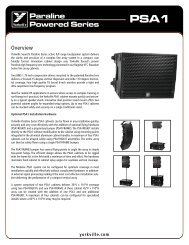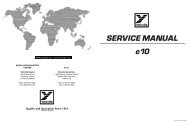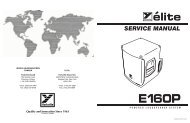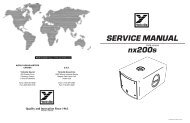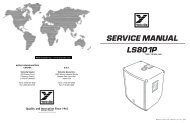AUDIOPRO AP1200 - Yorkville Sound
AUDIOPRO AP1200 - Yorkville Sound
AUDIOPRO AP1200 - Yorkville Sound
Create successful ePaper yourself
Turn your PDF publications into a flip-book with our unique Google optimized e-Paper software.
Quality and<br />
Innovation<br />
Since 1963<br />
OWNERS MANUAL<br />
MANUEL DE L'UTILISATEUR<br />
<strong>AUDIOPRO</strong> <strong>AP1200</strong><br />
TABLE OF CONTENTS<br />
PAGE<br />
2 Introduction<br />
2 Inputs<br />
3 Ground Strap<br />
3 Mono/Stereo/Bridge Switch<br />
4 SubSonic Filter Switch<br />
4 Limiter Switch<br />
4 Protect LED<br />
4 Short Circuit Protection<br />
4 DC Protection<br />
5 Thermal Protection<br />
5 Cooling<br />
5 Clip LEDs<br />
5 Power Configuration<br />
5 Other Design Details<br />
6 Energy Management System<br />
6 Reliability<br />
7 Applications<br />
7 Total Harmonic Distortion<br />
7,8 Specifications<br />
TABLE DES MATIÈRES<br />
PAGE<br />
10 Introduction<br />
10 Entrées<br />
11 Tresse de mise à la Terre<br />
11/12 Commutateur mono/stéréo/en pont<br />
12 Commutateur de Filtre Subsonique<br />
12 Commutateur de Limiteur<br />
12 D.E.L. Protectrice<br />
13 Protection Contre Les Court-Circuits<br />
13 Protection du CC<br />
13 Protection Thermique<br />
13 Refroidissement<br />
13 DEL d' Écretage<br />
13 Configuration de la Section de Puissance<br />
14 Autres Détails de Conception<br />
14 Système de Gestion Energétique<br />
15 Fiabilité<br />
15 Applications<br />
15 Distorsion Harmonique Totale<br />
16/17 Spécifications<br />
Before operating this unit, please read this manual thoroughly, and retain it for future use.<br />
REVISED 03/94 Printed in Canada<br />
Veuillez lire ce manuel attentivement avant d'utiliser l'appareil et le concerver pour consultations<br />
ultérieures.<br />
RÉVISÉ 03/94 Printed in Canada
INSTRUCTIONS PERTAINING TO A<br />
RISK OF FIRE, ELECTRIC SHOCK, OR<br />
INJURY TO PERSONS.<br />
CAUTION:<br />
TO REDUCE THE RISK OF ELECTRIC SHOCK,<br />
DO NOT REMOVE COVER (OR BACK).<br />
NO USER SERVICEABLE PARTS INSIDE.<br />
REFER SERVICING TO QUALIFIED<br />
SERVICE PERSONNEL.<br />
Read Instructions:<br />
The Owner’s Manual should be read and understood<br />
before operation of your unit. Please, save these<br />
instructions for future reference.<br />
Packaging:<br />
Keep the box and packaging materials, in case the unit<br />
needs to be returned for service.<br />
Warning:<br />
When using electric products, basic precautions should<br />
always be followed, including the following:<br />
Power Sources:<br />
Your unit should be connected to a power source only of the<br />
voltage specified in the owners manual or as marked on the unit.<br />
This unit has a polarized plug. Do not use with an extension cord or<br />
receptacle unless all three blades can be fully inserted to prevent<br />
blade exposure. Precautions should be taken so that the grounding<br />
scheme on the unit is not defeated.<br />
Power Cord:<br />
The AC supply cord should be routed so that it is unlikely that it will<br />
be damaged. If the AC supply cord is damaged DO NOT<br />
OPERATE THE UNIT.<br />
Service:<br />
The unit should be serviced only by qualified service personnel.<br />
IMPORTANT SAFETY INSTRUCTIONS<br />
safe_v3.doc Version 3.5 Mar 98<br />
INSTRUCTIONS RELATIVES AU<br />
RISQUE DE FEU, CHOC ÉLECTRIQUE,<br />
OU BLESSURES AUX PERSONNES.<br />
AVIS:<br />
AFIN DE RÉDUIRE LES RISQUE DE CHOC<br />
ÉLECTRIQUE, N’ENLEVEZ PAS LE COUVERT (OU<br />
LE PANNEAU ARRIÈRE). NE CONTIENT AUCUNE<br />
PIÈCE RÉPARABLE PAR L’UTILISATEUR.<br />
CONSULTEZ UN TECHNICIEN<br />
QUALIFIÉ POUR L’ENTRETIENT.<br />
Veuillez lire le manuel:<br />
Il contient des informations qui devraient êtres comprises<br />
avant l’opération de votre appareil. Conservez S.V.P. ces<br />
instructions pour consultations ultérieures<br />
Emballage:<br />
Conservez la boite au cas ou l’appareil devait être<br />
retourner pour réparation.<br />
Warning:<br />
Attention: Lors de l’utilisation de produits électrique,<br />
assurez-vous d’adhérer à des précautions de bases<br />
incluant celle qui suivent:<br />
Alimentation:<br />
L’appareil ne doit être branché qu’à une source d’alimentation<br />
correspondant au voltage spécifié dans le manuel ou tel qu’indiqué<br />
sur l’appareil. Cet appareil est équipé d’une prise d’alimentation<br />
polarisée. Ne pas utiliser cet appareil avec un cordon de<br />
raccordement à moins qu’il soit possible d’insérer complètement<br />
les trois lames. Des précautions doivent êtres prises afin d’eviter<br />
que le système de mise à la terre de l’appareil ne soit désengagé.<br />
Cordon d’alimentation:<br />
Évitez d’endommager le cordon d’alimentation. N’UTILISEZ PAS<br />
L’APPAREIL si le cordon d’alimentation est endommagé.<br />
Service:<br />
Consultez un technicien qualifié pour l’entretien de votre appareil.
<strong>AP1200</strong> OWNER MANUAL / GUIDE D'OPERATION<br />
INTRODUCTION<br />
INPUTS<br />
Your new <strong>Yorkville</strong> <strong>AUDIOPRO</strong> 1200 power amplifier is designed and built to provide years of trouble free<br />
performance. The <strong>AP1200</strong> starts with the field proven reliability of our innovative AP3000 power amp design<br />
and adds customer requested features like switchable limiters and a MONO/STEREO/BRIDGE switch. We’ve<br />
made the <strong>AP1200</strong> power configurable, (see “POWER CONFIGURATION”), which makes it the most versatile<br />
amp in its class. Our continuing research in the field of high power analog amplifier design has resulted in further<br />
reductions in distortion and noise, and even better power efficiency and line utilization. The AP3000 has set<br />
new standards in these categories - the <strong>AP1200</strong> exceeds them.<br />
The <strong>AP1200</strong> weighs a comfortable but solid 33 pounds, fits into two rack spaces, runs at near digital efficiency,<br />
reproduces music with over 2000 Watts of headroom, draws all the power it needs from a standard AC outlet,<br />
and has the best distortion and noise specifications you can find anywhere. It will drive reactive phase shifted<br />
loads with no difficulty - even though it is fully protected from accidental short circuits. Our design goal was<br />
to create an amplifier which would do exactly what an amplifier should do: reproduce music with great power,<br />
complete reliability, and uncompromising signal fidelity. We think you will agree that the <strong>Yorkville</strong><br />
<strong>AUDIOPRO</strong> 1200 does exactly that.<br />
We hope this manual will provide answers to any questions you may have about the features, controls, and<br />
characteristics of this amplifier.<br />
Balanced Inputs :<br />
Either “XLR” or two circuit “ring, tip, sleeve” STEREO 1/4" PHONE cords may be used. Each channel’s XLR<br />
input is internally paralleled with its phone input: The TIP of the channel “A” PHONE input is connected to<br />
pin 2 of its XLR input, the RING is connected to pin 3, and the SLEEVE is connected to PIN 1. PIN 2 is in phase,<br />
PIN 3 is 180 degrees out of phase, and PIN 1 is ground. We recommend using balanced lines for the best humfree<br />
performance, particularly when chaining multiple amplifiers.<br />
Unbalanced Inputs :<br />
Ordinary single circuit STANDARD 1/4" PHONE plugs may be used to connect unbalanced signals.<br />
IMPORTANT NOTE: Such plugs effectively connect the ring terminal to sleeve ground, so they work correctly.<br />
However, if you use a STEREO 1/4" PHONE plug on an unbalanced line, you MUST short the ring terminal<br />
to the sleeve terminal, otherwise the sensitivity will be 6dB lower than is specified! (The same applies to the<br />
XLR input: To connect an unbalanced source via the XLR input, you must connect the signal to PIN 2 and ground<br />
BOTH PIN 1 and PIN 3.)<br />
Remote Referencing:<br />
You can approach balanced performance with unbalanced sources by utilizing the remote reference feature of<br />
the <strong>AP1200</strong>. Connect a balanced cable to the <strong>AP1200</strong> just as you would if you were running a balanced line.<br />
At the other end, connect PIN 3 and PIN 1 together, (or connect ring to sleeve if you are using a PHONE plug<br />
cable), and plug this modified end into your unbalanced piece of equipment. This connection enables the<br />
<strong>AP1200</strong>’s input to “look” down the cable directly at the output jack of the unbalanced equipment. Any hum<br />
voltage generated across the cable’s impedance will be attenuated by the common mode rejection of the <strong>AP1200</strong><br />
Page 2
<strong>AP1200</strong> OWNER MANUAL / GUIDE D'OPERATION<br />
GROUND STRAP<br />
MONO/STEREO/BRIDGE<br />
SWITCH:<br />
Page 3<br />
Driving Multiple <strong>AP1200</strong> Amps:<br />
In large installations it is often desirable to operate many amplifiers in tandem. Since each channel’s XLR<br />
input is internally paralleled with its phone input, you may use the remaining input jack as an output to the<br />
next amplifier. Obviously you will need both XLR to XLR and PHONE to PHONE patch cords if you are<br />
going to tandem more than two amplifiers. NOTE: These patch cords MUST be balanced whether the input<br />
signal is balanced or unbalanced!<br />
The original source drives all of the amplifiers. Eighteen <strong>AP1200</strong> channels would present a load of about<br />
600 Ohms. Any source capable of driving a 600 Ohm line to +9 dBm should be able to drive this load with<br />
no problem.<br />
Removing the ground strap on the rear panel will disconnect chassis ground from circuit ground. Safety<br />
(“earth”) ground is still connected to the chassis. We do not recommend lifting the ground strap unless you<br />
are experiencing problems with ground loop hum in multiple amplifier setups where lifting the ground straps<br />
of all but one amplifier cures the hum problem. Caution: Sometimes hum problems are an indication of<br />
improper AC wiring somewhere else in your system. Don’t just doctor the symptom by lifting grounds: Fix<br />
the cause by making sure that the proper electrical wiring safety regulations have been adhered to.<br />
The <strong>AP1200</strong> can be configured for “dual MONO”, STEREO, or “BRIDGED MONO” operation via this rear<br />
panel MODE switch. The following is a description of each mode:<br />
Mono:<br />
- Channel “B” input is ignored. GAIN B has no effect.<br />
- Signal from input “A” is internally routed to both power amps.<br />
- Output signals are of equal amplitude and phase.<br />
- Two loads are driven.<br />
- Each load is connected between one BLACK and one RED post.<br />
Stereo:<br />
- Two independent amplifiers, Amp “A” and Amp “B”.<br />
- Two loads are driven.<br />
- Loads are connected between .0 and RED posts.<br />
Bridge:<br />
- Channel “B” input is ignored. GAIN B has no effect.<br />
- Signal from input “A” is internally routed to both power amps.<br />
- Output signals are equal in amplitude but opposite in phase.<br />
- One load is driven.<br />
- The load is connected between the two RED binding posts. The BLACK posts are not used.<br />
A word of CAUTION: The <strong>AP1200</strong> can deliver over 1200 Watts of power into a bridged load. <strong>Yorkville</strong>’s<br />
own high power speaker systems have circuit-breaker protection built in. Although these may shut down,<br />
they are unlikely to be damaged by a bridged <strong>AP1200</strong>. However, many other speaker manufacturers make<br />
“high power cabinets” with no protection features at all.
<strong>AP1200</strong> OWNER MANUAL / GUIDE D'OPERATION<br />
MONO/STEREO/BRIDGE<br />
SWITCH<br />
SUBSONIC FILTER SWITCH:<br />
LIMITER SWITCH:<br />
PROTECT LED:<br />
SHORT CIRCUIT<br />
PROTECTION:<br />
DC PROTECTION:<br />
<strong>Yorkville</strong> <strong>Sound</strong> LTD. is not responsible for any damage which may result as a consequence of exceeding such<br />
a speaker’s power handling capability. <strong>Yorkville</strong>’s two year unconditional warranty does not cover any<br />
consequential damages to non-<strong>Yorkville</strong> equipment. Please consider these facts carefully before you choose to<br />
run your <strong>AP1200</strong> in bridged mode!<br />
The <strong>AP1200</strong> features a specially designed subsonic filter which effectively blocks potentially destructive energy<br />
in the band below 30-Hz while enhancing the band between 35 and 70 Hz. Engaging this filter immediately<br />
produces the perception of a better “bottom end”, while excessive and possibly damaging excursions of the<br />
speaker cone are restrained. The filter provides an 18 dB/Oct skirt below 40 Hz and a 3.6 dB boost at 50 Hz.<br />
It is implemented with a five pole network designed to minimize phase shift down to 40 Hz. We recommend<br />
using this filter in conjunction with some subwoofers and with all high power full range cabinets. With the filter<br />
disabled, the <strong>AP1200</strong> is flat down to 20 Hz, and rolls off at 18 dB/Oct below that.<br />
With the internal limiters activated, the <strong>AP1200</strong>’s gain is continuously adjusted to fit the signal within the<br />
available dynamic range. Occasional clipping is permitted. The limiters will not only help to protect your<br />
system’s horns and tweeters, but will automatically make the best use of the available dynamic headroom. With<br />
the limiters activated, all you need to do is turn up the signal level until you start to see some clipping. The<br />
limiters will make sure that you are getting the maximum clean power output at all times. Setting the switch<br />
to the “OUT” position completely disables both limiters.<br />
In the event of a shorted load or a load which is of too low an impedance for the amplifier to handle, (less than<br />
2 ohms), the PROTECT LED will flash alternately on and off at about one second intervals. The sound may<br />
come on and off at the same rate. In this case, the fault is in the speakers or the speaker cables and should be<br />
located and remedied. No reset of the <strong>AP1200</strong> is required to restore proper operation.<br />
The <strong>AP1200</strong> is fully protected against all possible passive load conditions. It can operate with a “dead” short<br />
continuously without damage. (However, we don’t recommend that you short your <strong>AP1200</strong> “just for fun”. Shorts<br />
do create a lot of stress on the output devices.) The output stage uses a unique triple slope VI limiting scheme<br />
which is sophisticated enough to remain inert during transient currents in excess of 60 Amperes and phase angles<br />
of more than 45 degrees, yet is capable of protecting the output stage from damage due to accidental short circuits<br />
and improper loads.<br />
In the unlikely event of the <strong>AP1200</strong>’s outputs “going DC”, a thyristor circuit will short the output terminals and<br />
divert all potentially harmful currents away from your speakers.<br />
Page 4
<strong>AP1200</strong> OWNER MANUAL / GUIDE D'OPERATION<br />
THERMAL PROTECTION:<br />
COOLING:<br />
CLIP LEDS:<br />
POWER CONFIGURATION:<br />
OTHER DESIGN DETAILS:<br />
Page 5<br />
In the unlikely event that the <strong>AP1200</strong> overheats, the signal will be sporadically cut off and the PROTECT<br />
LED will flash. If further heating occurs, (due to some malfunction), an internal thermal breaker will<br />
interrupt the primary circuit. There is no visible indication of this rare condition. The <strong>AP1200</strong> is designed<br />
and tested to operate under “worst case” conditions without shutting down, so if you experience a thermal<br />
shutdown you should check for blocked air flow.<br />
The fan draws air in from the left side and expels hot air through the rear vents. This is compatible with<br />
our other amplifiers and with most installations. Since hot air rises, the heated air forcibly expelled from<br />
the back tends to rise away from the equipment rack. This draws cool air from the floor upwards into the<br />
sides of the rack. (It is much easier to draw air around corners than to blow air around corners.) In some<br />
cases where the rear of the rack is obstructed it may be necessary to install rack fans to aid cooling. If there<br />
are no obstructions, no secondary cooling is required.<br />
The CLIP LEDS on the front panel will visibly indicate any signal excursion beyond the dynamic headroom<br />
of the amplifier.<br />
The <strong>AP1200</strong> comes factory-configured to deliver its maximum power into a 2 Ohm load. However, it is<br />
possible to have your <strong>AP1200</strong> modified to deliver its maximum power into 4 Ohms. This modification<br />
should only be performed by a Certified Repair Technician. Your dealer can quickly have it done for you.<br />
This feature is intended to be used in fixed installations where the load is known and is not likely to change.<br />
PLEASE NOTE: In this non-standard 4 Ohm configuration, the minimum load per channel is 4 Ohms and<br />
the minimum BRIDGE load is 8 Ohms. Attempting to operate into 2 Ohm loads while in the 4 Ohm<br />
configuration will cause the amplifier to go into current limit, thermal limit, or both.<br />
In the non-standard 4 Ohm configuration, a red LED is glowing and is visable through the hole marked<br />
“STATUS R=4” on the rear panel next to the line cord. This enables a user to determine how the amplifier<br />
is configured.<br />
The POWER specification chart at the back of this manual shows the powers that can be obtained for various<br />
configurations and loads. For most applications you should stay with the 2 Ohm configuration.<br />
The <strong>AP1200</strong> represents a significant advance in the art and science of analog power amplifier design. It<br />
incorporates MOSFETS where they should be used - in the driver stage where their tube-like input<br />
impedance and immunity from secondary breakdown helps them drive bipolar output devices with greater<br />
reliability and power. The unique design of the output stage uses four supply voltages. This greatly reduces<br />
internal power dissipation. Rather than switching between the various supply voltages, the <strong>AP1200</strong><br />
smoothly directs its output stage to the appropriate supply. The output is thus free of the “glitches” that<br />
plague other multiple supply designs. In fact, due to the proprietary design of the power output section,
<strong>AP1200</strong> OWNER MANUAL / GUIDE D'OPERATION<br />
..... OTHER DESIGN DETAILS: the discontinuities visible on the distortion analysis product are much smaller than those normally associated<br />
with crossover distortion in single supply class AB designs. These circuit advances are clearly reflected in<br />
the superior specifications of the <strong>AP1200</strong>. The <strong>AP1200</strong> may be the first high power amplifier to offer<br />
specifications and sonic performance equal to or surpassing ultra low distortion designs such as class-A<br />
amplifiers.<br />
ENERGY MANAGEMENT<br />
SYSTEM:<br />
RELIABILITY:<br />
ANALOG vs DIGITAL:<br />
The <strong>AP1200</strong> is a high efficiency amplifier which is capable of delivering a greater percentage of its input<br />
power to the speaker load than most other amplifiers. Under actual operating conditions its power conversion<br />
efficiency approaches that of digital switching amplifiers. However, digital switching amps are plagued by<br />
poor specifications and cumbersome operating constraints. The <strong>AP1200</strong> provides the superior transient<br />
response and low distortion figures associated with the very best and most reliable analog designs. Digital<br />
amps don’t come close!<br />
The following discussion applies to 120 VAC 60Hz operation...<br />
All amplifiers with ratings above 1400 watts rely on the fact that the maximum power the amplifier is capable<br />
of providing is considerably greater than the average power required to reproduce music. Some amplifiers<br />
can deliver their full rated power continuously, but these may consume as much as 50 amperes in doing so.<br />
To get around that problem, many high power amplifiers are shipped with either a special high current plug<br />
on the line cord or with two line cords. In practice, the user is often forced to find some way to connect these<br />
products to standard line outlets. Due to the lower average power required by music, this will sometimes<br />
work, but there is the possibility that circuit breakers will trip during a performance.<br />
Given enough input power, the <strong>AP1200</strong> is fully capable of delivering its rated power continuously. However,<br />
<strong>AP1200</strong>’s power switch is also a circuit breaker with a 12 Amp rating, which limits the input power to 1440<br />
Watts. To work within this limit, the <strong>AP1200</strong> responds to high power demands by spreading its power supply<br />
conduction angle to increase its utilization of line power beyond what is normally achieved by capacitorfiltered<br />
power supply designs. This, together with the high efficiency of the <strong>AP1200</strong>’s output circuitry, means<br />
that the <strong>AP1200</strong> is able to deliver any kind of music program material at its full rated power into any load<br />
accepted by the amplifier - without tripping its 12 Amp breaker. It is nice to know that an <strong>AP1200</strong> will<br />
probably never “nuisance trip” its breaker.<br />
The <strong>AP1200</strong> is designed and manufactured by <strong>Yorkville</strong> <strong>Sound</strong> LTD. Each unit undergoes a thorough,<br />
temperature cycled burn-in period, and each circuit is tested by both manual and sophisticated computer<br />
controlled equipment which is capable of identifying any deviation from the design center parameters. The<br />
design of the <strong>AP1200</strong> is radical in concept but conservative with respect to the power handling capabilities<br />
of the output devices. The topology guarantees that thermal stress not secondary breakdown will set the limits<br />
of operation, while the computer optimized heat dissipation system insures that excessive thermal stress will<br />
not occur. <strong>Yorkville</strong>'s reputation as a manufacturer of reliable equipment will be further enhanced by the<br />
<strong>AP1200</strong>.<br />
Page 6
<strong>AP1200</strong> OWNER MANUAL / GUIDE D'OPERATION<br />
APPLICATIONS:<br />
TOTAL HARMONIC<br />
DISTORTION<br />
Page 7<br />
The <strong>AP1200</strong> was designed primarily for high power applications. It excels at driving big systems and<br />
subwoofers to their maximum SPL, and its rugged, road-worthy construction ensures that it will keep<br />
on doing just that - from location to location for years to come.<br />
The <strong>AP1200</strong> is not only suitable for use in both heavy duty touring sound reinforcement systems but also<br />
when high headroom and ultra-low distortion are needed to fully reproduce the dynamic range and clarity<br />
of today’s CD recordings. This last point needs emphasis: The <strong>AP1200</strong> will drive 8 Ohm loads with better<br />
sonic purity and lower distortion than any “listening amplifier” we know of, including those that cost<br />
much more. And, since the <strong>AP1200</strong> is built to survive grueling road conditions and constant 2 ohm<br />
operation, its reliability in a fixed installation running 4 or 8 ohm studio monitors is without parallel.<br />
Of course, what really counts is how it sounds. Listeners have commented that the <strong>AP1200</strong> provides the<br />
clearest most transparent reproduction they have ever heard. You will have to judge for yourself.<br />
(Measured at 1 dB below clipping, BW=80KHz, Filter=out, Limiter=out)<br />
TOTAL HARMONIC DISTORTION<br />
LOAD<br />
(OHMS)<br />
8
<strong>AP1200</strong> OWNER MANUAL / GUIDE D'OPERATION<br />
SPECIFICATIONS<br />
POWER:<br />
All values are in WATTS. Measurements were made at the 0.1% distortion point. Some CONTINUOUS<br />
AVERAGE POWER measurements required line currents greater than 15 Amps. The amplifier under test<br />
was plugged into an IDEAL POWER LINE consisting of a REGULATED 120 VAC RMS 60 Hz pure sine<br />
wave. Ordinary AC "wall outlet" lines will always exhibit varying and unpredictable amounts of sag. To<br />
produce objectively verifiable and accurate specifications these unknown factors must be eliminated by<br />
using an ideal AC line. When using an ordinary electrical outlet, it will usually be possible to get 1200 Watts<br />
when the <strong>AP1200</strong> is bridged into 4 ohms. The BURST measurements use two sine wave cycles at 100Hz<br />
and at 1KHz with a 1/8 second pause between bursts. The 100Hz burst power is a good indication of what<br />
the <strong>AP1200</strong> will deliver to a typical sub-woofer. The 1KHz burst represents the maximum possible sine<br />
wave output power. The <strong>AP1200</strong> comes from the factory in its STANDARD CONFIGURATION. However,<br />
it may be modified at your dealer’s service center for the non-standard 4 OHM CONFIGURATION. See<br />
“POWER CONFIGURATION” on page 5 of this manual for more details.<br />
ONE CHANNEL DRIVEN<br />
LOAD<br />
STANDARD CONFIGURATION MIN. 4 OHM CONFIGURATION<br />
(OHMS)<br />
CONT. AVG.<br />
100Hz<br />
BURST<br />
1KHz<br />
BURST CONT. AVG.<br />
100Hz<br />
BURST<br />
1KHz<br />
BURST<br />
8 325 375 400 425 500 525<br />
4 575 650 750 750 950 1000<br />
2 825 1050 1350 n/a n/a n/a<br />
BOTH CHANNELS CHANNEL DRIVEN<br />
LOAD<br />
STANDARD CONFIGURATION MIN. 4 OHM CONFIGURATION<br />
(OHMS)<br />
CONT. AVG.<br />
100Hz<br />
BURST<br />
1KHz<br />
BURST CONT. AVG.<br />
100Hz<br />
BURST<br />
1KHz<br />
BURST<br />
8 300 350 400 400 500 525<br />
4 500 625 750 625 900 1000<br />
2 650 1025 1325 n/a n/a n/a<br />
BRIDGE CONNECTION<br />
LOAD<br />
STANDARD CONFIGURATION MIN. 4 OHM CONFIGURATION<br />
(OHMS)<br />
CONT. AVG.<br />
100Hz<br />
BURST<br />
1KHz<br />
BURST CONT. AVG.<br />
100Hz<br />
BURST<br />
1KHz<br />
BURST<br />
8 975 1250 1500 1275 1800 2000<br />
4 1300 2000 2600 n/a n/a n/a<br />
2 n/a n/a n/a n/a n/a n/a<br />
Page 8
<strong>AP1200</strong> OWNER MANUAL / GUIDE D'OPERATION<br />
SPECIFICATIONS CROSS TALK: -75 dB below full output at 1KHz,-60 dB below full output, 20 Hz - 20 KHz.<br />
Page 9<br />
INPUT IMPEDANCE: 30Kohms balanced, 20 Kohms unbalanced.<br />
INPUT SENSITIVITY: 1.4 VRMS sine wave = full power. (33 dB gain).<br />
CMRR (bal input): Typical 66 dB, minimum 54 dB. (20 Hz - 20 KHz).<br />
CONTROLS: Rotary GAIN controls, MONO/STEREO/BRIDGE, FILTER, LIMITER<br />
switches.<br />
DISPLAYS: 2x CLIP, 2x ACTIVITY, PROTECT, POWER ON. (LEDS)<br />
FREQ. RESPONSE: Within 1dB, 20 Hz to 20 KHz, (50 Hz boost SW out).<br />
HUM AND NOISE: -103 dB below max output RMS voltage, unweighted.<br />
DC OFFSET: Less than 30 millivolts.<br />
PROTECTION: Fully protected: DC, LOAD and THERMAL.<br />
COOLING: Anodized AL. Heatsink with DC servo controlled fan.<br />
SLEW RATE: Power amp: 25 V/uS, 50 V/uS in bridged mode.Rise time limited to 18 V/<br />
uS by input filter).<br />
DAMPING FACTOR: > 600, 20 Hz - 400 Hz, into 8 ohms. (plenty)<br />
MAX OUTPUT AMPS: 60 Amperes repetitive peak, 30 amperes continuous into resistive loads.<br />
60 Amps peak and 30 Amps for 20mS repetitive at 0 voltage point when<br />
driving phase shifted loads.<br />
TURN ON/OFF: < 15 milliwatt / seconds, 0.5 Wpk. (1s on delay)<br />
EFFICIENCY: Better than 75% at full power into 4 Ohms.<br />
WEIGHT: 33 pounds. 15 Kilograms.<br />
SIZE: 3.5" x 19" x 15.75 (front panel to binding posts)<br />
TRANSFORMER: Toroidal.<br />
POWER<br />
CONSUMPTION: Will not exceed 1440 Watts.
<strong>AP1200</strong> OWNER MANUAL / GUIDE D'OPERATION<br />
INTRODUCTION<br />
ENTRÉES<br />
Votre nouvel amplificateur de puissance <strong>AUDIOPRO</strong> AP-1200 a été conçu et fabriqué pour vous servir<br />
avec fiabilité pour bien des années à venir.Avec des caractéristiques comme un limiteur commutable et<br />
un sélecteur MONO/STEREO/EN PONT, le AP-1200 s’introduit au marché appuyé par la fiabilité déja<br />
prouvée du AP-3000. Les différentes possibilitées de configuration de la section de puissance (voir:<br />
CONFIGURATION DE LA SECTION DE PUISSANCE) font du AP-1200 l’amplificateur le plus<br />
versatile de sa catégorie. Nos recherches continues dans le domaine des conceptions d’amplificateur de<br />
haute puissance ont résulté en une réduction du taux de distortion et du bruit en plus d’une utilisation<br />
plus efficace de la puissance et une meilleur gestion du courant de ligne. Le AP-3000 avait établi de<br />
nouveaux standards dans ces catégories, le AP-1200 les surpasse.<br />
Le AP-2000 a un poids de 33 livres, s’installe dans deux espaces de rack standard, fonctionne avec une<br />
efficacité qui se rapproche de celle des conceptions numériques, reproduit la musique avec au-delà de 2000<br />
watts d’extention dynamique, tire toute la puissance requise d’une prise CA standard et possède des<br />
spécifications pour le bruit et la distortion incomparables. Il peut conduire une charge réactive et déphasée<br />
sans difficulté, tout en restant pleinement protegé contre les court-circuits accidentels. Notre but était de<br />
conçevoir un amplificateur avec une fonction bien définie: reproduire la musique avec puissance et fidèlité<br />
tout en étant extrêmement fiable. Nous sommes confiant que vous serez d’accord que le AP-1200 remplit<br />
ses fonctions de façon impéccable.<br />
Nous espérons que ce manuel répondera aux questions que vous pourriez avoir espérons que ce manuel<br />
répondera au question que vous pourriez avoir au sujet des caractéristiques particulières du AP-1200.<br />
ENTRÉES SYMÉTRIQUES<br />
Deux modèles de connecteur peuvent être utilisés pour les entrées symétriques: XLR ou prise phono 1/4"<br />
à double circuit (stéréo) pointe/couronne/manchon.La prise XLR de chaque canal, étant intérieurement<br />
branchée en parallèle avec la prise phono 1/4 correspondante (XLR-PHONO canal A =parallèle, XLR-<br />
PHONO canal B=parallèle) : la pointe de la prise d’entrée 1/4 du canal A est branchée à la tige 2 de la prise<br />
XLR du canal A. La couronne est branchée à la tige 3 et le manchon à la tige 1. La tige 2 est en phase, la<br />
tige 3 est en opposition de phase et la tige 1 est branchée à la masse. L’utilisation des entrées symétriques<br />
vous permettra d’obtenir une meilleur performance au niveau signal/bruit, particulièrement dans un<br />
montage à multiple amplificateurs.<br />
ENTRÉES ASSYMÉTRIQUES<br />
Des prises phono à circuit simple (mono) standard peuvent être utilisées pour les signaux assymétriques.<br />
NOTE IMPORTANTE: Lors de l’utilisation d’un tel connecteur, la tige du AP-1200 qui connecte<br />
normalement avec la couronne d’une prise stéréo fait contact avec le manchon (masse) pour permettre un<br />
bon fonctionnement en mode assymétrique. Si toutefois vous utilisez une prise stéréo avec un signal<br />
assymétrique, vous devez court- circuiter la tige de la couronne avec la tige du manchon du connecteur pour<br />
éviter une diminution du niveau du signal de 6dB par rapport aux spécifications. La même méthode<br />
s’applique avec l’utilisation de prise XLR: pour brancher un signal assymétrique avec une prise XLR vous<br />
devez brancher le signal à la tige 2 et brancher les tiges 1 et 3 à la masse.<br />
Page 10
<strong>AP1200</strong> OWNER MANUAL / GUIDE D'OPERATION<br />
TRESSE DE MISE A LADébrancher<br />
la tresse de mise à la terre sur le panneau arrière de AP-3000 découple la masse entre le châssis<br />
TERRE<br />
et le circuit. La mise à la terre de sûreté demeure toutefois branchée au châssis. A moins que vous n’ayez des<br />
problèmes de bourdonnement due à la boucle de masse nous vous recommandons de laisser la tresse de mise<br />
à la terre branchée. ATTENTION: Les problèmes de bourdonnement indiquent parfois un mauvais câblage AC<br />
dans votre système. Ne réglez pas ces problèmes en levant simplement les tresses de mises à la terre: assurezvous<br />
que votre câblage électrique est en accord avec les normes de sécurité.<br />
COMMUTATEUR MONO/<br />
STÉRÉO/EN PONT<br />
Page 11<br />
CARACTERISTIQUE DE REFERENCE A DISTANCE<br />
Avec la caractéristique de référence à distance du AP-1200, une performance comparable à celle obtenue avec<br />
l’utilisation d’un signal symétrique est possible même avec une source assymétrique. Branchez un cable<br />
symétrique à l’entrée du AP-1200 tout comme si vous utilisiez un signal symétrique. A l’autre extrémité de ce<br />
cable faites un contact entre les tiges 3 et 1 (si vous utilisez une prise phono faites un contact entre la couronne<br />
et le manchon) et branchez cette extrémité à votre appareil assymétrique. Ce type de branchement permet à<br />
l’entrée du AP-1200 de percevoir le signal directement à la prise de sortie de l’appareil assymétrique par<br />
l’entremise de ce fil symétrique. Tout bourdonnement de voltage généré à travers l’impédance du cable va être<br />
atténué avec le rapport de réjection en mode commun du AP-1200.<br />
MONTAGE A MULTIPLE AP-1200<br />
Pour de larges opérations, il est souvent nécessaire d’utiliser plusieurs amplificateurs en tandem. La prise XLR<br />
de chaque canal, étant intérieurement branchée en parallèle avec la prise phono 1/4 correspondante (XLR-<br />
PHONO canal A =parallèle, XLR-PHONO canal B=parallèle), la prise d’entrée inutilisée peut être utilisée<br />
comme sortie pour diriger le signal vers un autre amplificateur. Vous aurez alors besoin des deux types de cable<br />
(XLR- XLR et Phono-Phono) si vous avez l’intention de brancher plus de deux AP-1200 en parallèle. NOTE:<br />
Chacun de ces fils de raccordement doit être symétrique peu importe le type de signal utilisé (symétrique ou<br />
assymétrique). La source originale doit entrainer tous les autres. Dix-huit AP-1200 représentent une charge<br />
d’environ 600 ohms. N’importe quelle source capable de fournir un niveau de +9dB à 600 ohms devrait être<br />
capable de piloter cette charge sans problème.<br />
Le AP-1200 peut être configuré pour opération en mode “mono”,”stéréo”,”en pont” avec le sélecteur<br />
désigné par “mode” sur le panneau arrière. Voici une description de chaque mode:<br />
MONO:<br />
-L’entrée du canal B est ignorée. Le gain B n’a aucun effet.<br />
-Le signal à l’entrée du canal A est intérieurement dirigé vers les deux amplificateurs de puissance.<br />
-La phase et l’amplitude des signaux présents à chaque sortie est la même.<br />
-Une charge est branché par sortie.<br />
-Chacune des charge est branchée à un terminal rouge et un terminal noir.<br />
STÉRÉO:<br />
-Deux amplificateurs internes indépendants. Amp A et Amp B.<br />
-Une charge est branchée à chaque amplificateur.<br />
-Chacune des charges est branchée à un terminal rouge et un terminal noir
<strong>AP1200</strong> OWNER MANUAL / GUIDE D'OPERATION<br />
COMMUTATEUR MONO/<br />
STÉRÉO/EN PONT<br />
COMMUTATEUR DE FILTRE<br />
SUBSONIQUE<br />
COMMUTATEUR DE LIMITEUR<br />
D.E.L. PROTECTRICE<br />
EN PONT:<br />
-L’entrée du canal B est ignorée. Le gain B n’a aucun effet.<br />
-Le signal à l’entrée du canal A est intérieurement dirigé vers les deux amplificateurs de puissance.<br />
-Les signaux de sortie sont d’amplitude égale mais de phase opposée.<br />
-Une seule charge est branchée à l’amplificateur.<br />
-La charge est branchée aux deux terminaux rouges. Les terminaux noirs ne sont pas utilisés.<br />
ATTENTION: Un disjoncteur de protection est encastré dans les systèmes de haut-parleurs haute puissance<br />
de <strong>Yorkville</strong>. Quoiqu’ils peuvent cesser temporairement de fonctionner, il est peu probable qu’ils soient<br />
endommagés par un AP-1200 opéré en pont. Toutefois, plusieurs fabriquants produisent des cabinets haute<br />
puissance sans protection.<br />
<strong>Yorkville</strong> <strong>Sound</strong> Ltd n’est responsable d’aucun dommage qui pourrait être causé par un excès de puissance<br />
appliqué sur des haut-parleurs incapables de la soutenir. La garantie inconditionnelle de 2 ans de <strong>Yorkville</strong><br />
ne couvre en aucun cas, les dommages causé aux équipments ne provenant pas de <strong>Yorkville</strong> par suite d’un<br />
malfonctionnement de l’un de nos appareil. Veuillez S.V.P. considerer attentivement ces faits avant de<br />
considerer utiliser votre AP-1200 en mode “montage en pont”.<br />
Le AP-1200 possède un filtre subsonique spécialement conçu pour bloquer les fréquences inférieures à<br />
30Hz et pour accentuer la bande de fréquence entre 35 et 70 Hz.Une meilleure perception des basses<br />
fréquences et une protection contre les excursions excessives qui pourraient possiblement endommager les<br />
haut-parleurs sont les résultats obtenus suite àl’engagement de ce filtre subsonique. Ce filtre prévoit une<br />
coupure de 18dB/Oct en-dessous de 40 Hz et une augmentation de 3.6dB à 50Hz. La conception du réseau<br />
à 5 pôles permet de minimiser les décalages de phase à 40 Hz. Nous vous recommandons l’utilisation de<br />
ce filtre en conjonction avec certains modèles de cabinet pour sous-grave et tous les cabinets pleine-bande.<br />
Lorsque le filtre est désengagé, le AP-1200 offre une réponse en fréquence stable jusqu’à 20Hz, avec une<br />
coupure de 18dB/Oct pour les fréquence en-dessous de 20 Hz.<br />
Lorsque les limiteurs internes sont activés, les gains du AP-1200 sont constamment ajustés de façon à régler<br />
le niveau du signal dans les limites de l’extention dynamique disponible. L’écrêtage occasionnel est permit.<br />
En plus de fournir une protection suplémentaire aux haut-parleurs à pavillon (Horns) et aux Tweeters de<br />
votre système, les limiteurs feront automatiquement le meilleur usage possible de l’extention dynamique<br />
du Ap-1200. Avec les limiteurs activés, vous n’avez qu’à augmenter le niveau du signal jusqu’à ce que<br />
l’écrêtage occasionnel se produise. Les limiteurs assurent un maximum de puissance de sortie sans écrêtage<br />
en tout temps. Réglez le sélecteur à la position “OUT” désengage complètement chaque limiteur.<br />
Lorsque le système de gestion énergétique est activé, la D.E.L. protectrice reste constamment illuminée.<br />
Lorsqu’une charge court-circuitée ou une charge dont l’impédance est inférieure à ce que l’amplificateur<br />
peut supporter (moins de 2 ohms) se présente à celui-ci, la D.E.L. protectrice clignote à un intervalle<br />
d’environ une seconde. Le son peut être coupé et activé à la même fréquence. Dans ce cas, on doit localiser<br />
et régler le problème qui réside dans les haut-parleurs ou dans le câblage des haut-parleurs. Aucun réglage<br />
du AP-1200 n’est nécessaire pour restorer le mode d’opérattion.<br />
Page 12
<strong>AP1200</strong> OWNER MANUAL / GUIDE D'OPERATION<br />
PROTECTION CONTRE LES<br />
COURT-CIRCUITS<br />
PROTECTION DU CC<br />
PROTECTION THERMIQUE<br />
REFROIDISSEMENT<br />
DEL D’ÉCRETAGE<br />
CONFIGURATION DE LA<br />
SECTION DE PUISSANCE<br />
Page 13<br />
Le AP-1200 est pleinement protégé contre toute condition possible de charge passive. Il peut opérer sans danger<br />
d’être endommagé avec une charge court-circuitée.(Nous ne vous recommandons toutefois pas de brancher une<br />
telle charge seulement “pour le plaisir”. Un court-circuit crée une forte tension sur les appareils de sortie).<br />
L’étage de sortie utilise un arrangement limiteur à triple pentes d’atténuation suffisament sophistiqué pour<br />
demeurer neutre durant les transitoires de courant qui excède 100 ampères et les angles de phase de plus de 45°<br />
tout en protégeant l’étage de sortie contre les dommages causés par des charges court-circuitées ou des charges<br />
trop basses accidentelles.<br />
S’il arrivait par hazard que les sorties du AP-1200 laissaient passer du CC, un circuit à thyristor court-circuite<br />
automatiquement les terminaux de sortie et dirige le courant, qui présente un danger<br />
potentiel, à l’écart des haut-parleurs.<br />
Il est peut probable que le AP-1200 surchauffe, mais si cela se produit le signal est coupé de façon sporadique<br />
et la DEL désignée par “PROTECT LED” clignote. Si le surchauffage persiste (due à un<br />
malfonctionnement,) le circuit primaire est alors interrompu par le disjoncteur thermique interne. Il n’y a<br />
aucune indication apparante qu’un tel surchauffage pourrait survenir. Le AP-1200 a été conçu et<br />
testé pour opérer sous des conditions extrêmes sans interrompre son fonctionnement. Si cela devait se produire,<br />
assurez-vous que les bouches d’aération ne sont pas obstruées.<br />
Le système de refroidissement compatible avec les autres amplificateurs YORKVILLE et la plupart des<br />
installations aspire l’air par les côtés et la repousse par les bouches d’aération à l’arrière. Puisque l’air chaud<br />
se dirige naturellement vers le haut, l’air chaud qui sort par les bouches d’aération tend à s’éloigner du rack.(Il<br />
est plus facile de tirer l’air par les côtés que de la repousser par les côtés). Il peut être nécessaire d’installer<br />
des ventillateurs si l’arrière du rack s’il est obstrué.S’il n’y a pas d’obstruction, aucune ventillation<br />
additionnelle n’est requise.<br />
Les DEL d’écrêtages sur le panneau avant indiquent les excursions au-delà de l’extention dynamique de AP-<br />
1200.<br />
Le AP-1200 est préréglé à l’usine pour livrer un maximum de puissance avec une charge de 2 ohms.<br />
Il est toutefois possible de modifier l’AP-1200 pour obtenir un maximum de puissance avec une charge de 4<br />
ohms. Cette modification ne devrait être faite que par un technicien qualifié. Veuillez vous référer à votre<br />
vendeur YORKVILLE autorisé.<br />
Cette caractéristique a été prévue pour les amplificateurs destinés à des installations permanentes ou la charge<br />
est connue et stable. NOTE IMPORTANTE:Avec cette configuration inhabituelle à 4 ohms, la charge minimum<br />
par canal est de 4 ohms et la charge minimum pour l’opération en pont est de 8 ohms. Tenter d’opérer<br />
l’amplificateur avec une charge de 2 ohms alors que le AP-1200 est en configuration à 4 ohms forcera<br />
l’amplificateur à entrer dans les phases de limitage de courant, limitage due au surchauffage ou les deux.<br />
Une DEL rouge, visible à travers le trou identifié par “STATUS R=4”sur le panneau arrière près du cordon de<br />
ligne, indique la configuration inhabituelle à 4 ohms. Cela permet à l’usager d’identifier le mode d’opération<br />
de l’amplificateur. La charte à la fin de ce manuel démontre les différentes puissances qui peuvent être obtenues<br />
avec des charges et des mode variés. La configuration à 2 ohms est souhaitable pour la plupart des opérations.<br />
Le AP-3000 représente un avancement considérable dans l’art et la science de la conception de l’amplificateur<br />
analogue.
<strong>AP1200</strong> OWNER MANUAL / GUIDE D'OPERATION<br />
AUTRES DETAILS DE<br />
CONCEPTION<br />
SYSTEME DE GESTION<br />
ENERGETIQUE<br />
Les transistors à effet de champ sont incorporés à l’étage pilote où leur immunité contre les claquement<br />
secondaire leur permet d’entrainer, avec fiabilité, les pièces<br />
de sortie bipolaires avec plus de fiabilité et plus de puissance. La conception unique de l’étage de sortie<br />
utilise quatre tensions de réseau, ce qui réduit considérablement la dissipation de puissance interne. Plutôt<br />
que d’utiliser la commutation entre plusieurs tension de réseau, le AP-3000 dirige sont étage de sortie sur<br />
le réseau approprié, ce qui libère la sortie des transitoires qui tourmente<br />
les autres conception à multiple alimentations. En fait, due au proprietés de la conception de la section de<br />
sortie, les discontinuitées visibles sur l’analyse de distortion sont considérablement plus petites que ceux<br />
normallement associés avec la distortion de croisement dans un amplificateur<br />
de classe AB à alimentation simple. Les spécifications supérieures du AP-1200 reflète clairement la<br />
perfection de ses circuits. Le AP-1200 est probablement le premier amplificateur haute puissance à offir<br />
des spécifications et une performance audio équivalente où supérieur à celles des amplificateurs à distortion<br />
très basse telle que les amplificateurs “classe A”.<br />
ANALOGUE CONTRE NUMÉRIQUE:<br />
Le AP-1200 est un amplificateur de puissance de haute efficacité capable de livrer à sa sortie, un plus grand<br />
pourcentage de la puissance qu’il possède à l’entrée que la plupart des amplificateurs. Sous des conditions<br />
d’opération véritables, l’efficacité du AP-1200 à convertir la puissance se rapproche de celle des<br />
conceptions numériques. Les amplificateurs numériques sont toutefois tourmentés par des spécifications<br />
médiocres et des contraintes d’opération encombrantes. Le AP-1200 offre une réponse supérieure pour les<br />
transitoires et des spécifications de distortion associées avec les meilleures conceptions analogues. Aucun<br />
amplificateur numérique peut en faire autant.<br />
La discussion qui suit implique une opération avec 120 VCA 60 Hz.<br />
Tous les amplificateurs qui ont une puissance nominale au-dessus de 1400 watts comptent sur le fait que<br />
la puissance moyenne requise pour reproduire la musique est considérablement en-dessous de la puissance<br />
maximum que l’amplificateur est capable de fournir. Quelques-uns de ces amplificateurs peuvent vraiment,<br />
de façon continue, propopulsés la puissance pour laquelle ils sont classés, mais en opérant ainsi, ils peuvent<br />
consommer jusqu’a 50 ampères. Pour contourner ce problème, plusieurs amplificateurs sont expédiés avec<br />
soit une prise spéciale pour courant élevé sur le cordon d’alimentation, soit deux cordons d’alimentation.<br />
En pratique, l’utilisateur est souvent forcé de trouver une façon de brancher ces appareils à une prise de<br />
courant standard. Parce que la musique requiert normalement une puissance moyenne moins élevée, cela<br />
peut parfois fonctionner, mais il y a alors une possibilité que le circuit disijoncteur de la salle de concert<br />
déclanche.<br />
Avec la puissance d’entrée requise, le AP-1200 est pleinement capable de livrer à sa sortie la puissance<br />
nominale de façon continue. La puissance d’entrée est toutefois limitée à 1440 watts, avec le commutateur<br />
de mise en marche qui agit en même temps comme disjoncteur de douze ampères. Pour opérer à l’intérieur<br />
de ces limites, le AP-1200 répond à la grande demande de puissance en agrandissant l’angle de conduction<br />
du bloc d’alimentation pour améliorer l’utilisation de la puissance de ligne au-delà de celle normallement<br />
associée avec les blocs d’alimentation conventionnels. Cela en conjonction avec la haute efficacité du<br />
circuit de sortie du AP-1200, indique que le AP-1200 est capable de livrer n’importe quel matériel musical,<br />
à sa pleine puissance, avec n’importe quelle charge acceptée par l’amplificateur sans déclancher le<br />
disjoncteur de douze ampères. Il est rassurant de savoir que le AP-1200 ne déclanchera probablement jamais<br />
son disjoncteur.<br />
Page 14
<strong>AP1200</strong> OWNER MANUAL / GUIDE D'OPERATION<br />
FIABILITE[<br />
APPLICATIONS<br />
DISTORSION HARMONIQUE<br />
TOTAL<br />
Page 15<br />
Le <strong>AUDIOPRO</strong> AP-1200 a été conçu et fabriqué par <strong>Yorkville</strong> <strong>Sound</strong> Ltd. Chaque appareil subit une période<br />
de rodage minutieuse et chaque circuit est testé manuellement ainsi qu’avec de l' équipment controllé par<br />
ordinateur. L’<strong>AUDIOPRO</strong> AP-1200 représente un changement de concept radical mais demeure toutefois<br />
conservateur par rapport à sa puissance nominale. L’étude des propriétés garantie que la contrainte thermique,<br />
et non les claquements sécondaire, déterminera la limite d’opération alors que le système de dissipation de<br />
chaleur assure la limitation des contraintes thermiques. La réputation de fabriquant d’appareil fiable de<br />
<strong>Yorkville</strong> ne peut être qu’accrue avec le AP-1200.<br />
Le <strong>AUDIOPRO</strong> AP-1200 a été conçu pour les opérations où une haute puissance est requise. Il est excellent pour<br />
obtenir des systèmes importants et des haut-parleurs de grave une pression sonore maximum et sa construction<br />
robuste vous assure une fiabilité à toute épreuve pour bien des années à venir.<br />
Le <strong>AUDIOPRO</strong> AP-1200 est non seulement excellent pour les situations qui demandent un grand rendement,<br />
mais il excelle aussi à reproduire la clarté des enregistrements sur disque compact où une extention dynamique<br />
considérable et un très bas taux de distortion sont nécessaires. Le <strong>AUDIOPRO</strong> AP-1200 peut conduire une<br />
charge de 8 ohms avec une meilleur qualité sonore et un taux de distortion plus bas que n’importe quel<br />
amplificateur d’écoute que nous connaissons. Considérant le fait que le AP-1200 peut survivre des conditions<br />
d’opération constantes à 2 ohms, sa fiabilité dans une installation fixe à 4 où 8 ohms est sans pareille. Bien sûr,<br />
ce qui importe, c’est la qualité sonore. Les auditeurs sont d’accord pour affirmer que le <strong>AUDIOPRO</strong> <strong>AP1200</strong><br />
assure une reproduction claire et transparente incomparable. Soyez-en vous même le juge.<br />
(Mesures prises à 1 dB en-dessous du niveau d'écrêtage, L de B = 80KHz, Filtre = désengager<br />
Limiteur = désengager)<br />
DISTORSION HARMONIQUE TOTALE<br />
CHARGE<br />
(OHMS)<br />
8
<strong>AP1200</strong> OWNER MANUAL / GUIDE D'OPERATION<br />
SPÉCIFICATIONS<br />
BOTH CHANNELS DRIVEN<br />
Le text qui suit contient les spéçifications préliminaires pour l’amplificateur de puissance AP-1200.<br />
PUISSANCE: Toutes les valeurs sont en watts avec l’utilisation d’un signal de test de 1KHz. Une<br />
onde sinuozidale de 60Hz avec une puissance régularisée de 120 VCA RMS est utilisé pour<br />
prendre les mèsures. La mesure de pointede puissance est prise avec des points de deux cycles à 1KHz à un rapport<br />
de 8:1. Les résultats véritable avec de la musique et cabinets à haut-parleur sera<br />
toujours comparable à un ou l’autre. Le AP-1200 quitte la manufacture en configuration standard.<br />
Il peut toutefois être modifié à un centre de service autorisé pour opérer en configuration inhabituelle<br />
de 4 ohms.(pour plus d’information voir la section (“CONFIGURATION DE LA SECTION DE<br />
PUISSANCE”) dans ce manuel.<br />
ONE CHANNEL DRIVEN<br />
LOAD<br />
STANDARD CONFIGURATION MIN. 4 OHM CONFIGURATION<br />
(OHMS)<br />
CONT. AVG.<br />
100Hz<br />
BURST<br />
1KHz<br />
BURST CONT. AVG.<br />
100Hz<br />
BURST<br />
1KHz<br />
BURST<br />
8 325 375 400 425 500 525<br />
4 575 650 750 750 950 1000<br />
2 825 1050 1350 n/a n/a n/a<br />
BOTH CHANNEL DRIVEN<br />
LOAD<br />
STANDARD CONFIGURATION MIN. 4 OHM CONFIGURATION<br />
(OHMS)<br />
CONT. AVG.<br />
100Hz<br />
BURST<br />
1KHz<br />
BURST CONT. AVG.<br />
100Hz<br />
BURST<br />
1KHz<br />
BURST<br />
8 300 350 400 400 500 525<br />
4 500 625 750 625 900 1000<br />
2 650 1025 1325 n/a n/a n/a<br />
BRIDGE CONNECTION<br />
LOAD<br />
STANDARD CONFIGURATION MIN. 4 OHM CONFIGURATION<br />
(OHMS)<br />
CONT. AVG.<br />
100Hz<br />
BURST<br />
1KHz<br />
BURST CONT. AVG.<br />
100Hz<br />
BURST<br />
1KHz<br />
BURST<br />
8 975 1250 1500 1275 1800 2000<br />
4 1300 2000 2600 n/a n/a n/a<br />
2 n/a n/a n/a n/a n/a n/a<br />
Page 16
<strong>AP1200</strong> OWNER MANUAL / GUIDE D'OPERATION<br />
Page 17<br />
Transmodulation: 75 dB en-dessous de la puissance total à 1 KHz.-60 dB en-dessous de<br />
la puissance total, 20Hz - 20KHz<br />
Impédance de L’Entrée: 30 Kohms symétrique, 10 Kohms assymétrique.<br />
Sensibilité d’entrée: 1.4 VRMS onde sinuozidale = pleine puissance(33 dB de gain)<br />
CMRR (Entré symétrique): >31 dB 20 Hz - 20 KKHz<br />
Contrôles: Gain rotatif, Mono,Stéréo, en pont, filtre subsonique spécial et limiteur.<br />
Affichage DEL: 2 x écrêtage, 2 x activités, protection, alimentation.<br />
R éponse en Fréquence: A 1 dB près, 20 Hz - 20 KHz (sw. de renforcement hors-circuit).<br />
Bruit et Hum: 103 dB en-dessous de la sortie max. de voltage RMS, nonpondéré.<br />
Compensation: Moins de 30 millivolts.<br />
Protection: Pleinement protegé; DC, charge, Thermique.<br />
Refroidissement: Dissipateur de chaleur interfolié avec ventillateur<br />
controlé par servo CC.<br />
Vitesse de Propagation: Amp. de puissance 25 V/USEC, 50 V/USec, en mode “en pont”<br />
(temps de monté limité à 18 USEC par le filtre d’entrée).<br />
Coéfficient D;<br />
Amortissement: >600, 20 Hz - 400 Hz, à 8 ohms (amplement).<br />
Sortie Maximum<br />
de Courant: 60 ampères pour 2 millisecondes, 30 ampères continues point de 60<br />
ampères et 30 ampères pour 20 millisecondes a 0 volt avec une charge<br />
déphase.<br />
Mise en marche/Coupure:
WORLD HEADQUARTERS<br />
CANADA<br />
<strong>Yorkville</strong> <strong>Sound</strong><br />
550 Granite Court<br />
Pickering, Ontario<br />
L1W-3Y8 CANADA<br />
Voice: (905) 837-8481<br />
Fax: (905) 837-8746<br />
U.S.A.<br />
<strong>Yorkville</strong> <strong>Sound</strong> Inc.<br />
4625 Witmer Industrial Estate<br />
Niagara Falls, New York<br />
14305 USA<br />
Voice: (716) 297-2920<br />
Fax: (716) 297-3689<br />
Quality and Innovation Since 1963<br />
Printed in Canada



